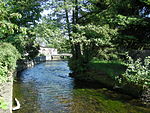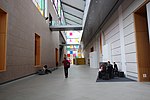Canal de la Bruche

The Canal de la Bruche is a canal in eastern France that originally connected Soultz-les-Bains, near Molsheim, to the city of Strasbourg. It was built in 1682 by the famous military engineer Vauban, principally to transport sandstone from the quarries of Soultz for use in the construction of the fortifications of Strasbourg. The last commercial load was carried in 1939 and the canal formally closed in 1957, after bridges damaged during World War II were rebuilt with insufficient headroom for navigation.The canal is 20 kilometres (12 mi) long and has 11 locks on its course, with a total rise of almost 30 metres (98 ft). It roughly parallels the river Bruche (river), taking its water supply from the confluence of the Bruche and Mossig rivers at Wolxheim, with a secondary supply downriver at Kolbsheim. It enters the river Ill at Montagne Verte in Strasbourg, just downstream of the confluence of the Bruche and Ill, and some 2.5 kilometres (1.6 mi) upstream of the centre of the city. When the canal was built, the Ill provided navigable connections to the city and the Rhine, and in later years to the Canal du Rhone au Rhine and the Canal de la Marne au Rhin.Although no longer navigable, the canal is retained in water, and is now managed by the Conseil Départemental du Bas-Rhin. The towpath has been converted into a cycle path, which forms part of the 3,900-kilometre (2,400 mi) long EuroVelo 5 route that links London with Brindisi.
Excerpt from the Wikipedia article Canal de la Bruche (License: CC BY-SA 3.0, Authors, Images).Canal de la Bruche
Quai du Canal de la Bruche, Strasbourg Montagne-Verte
Geographical coordinates (GPS) Address Nearby Places Show on map
Geographical coordinates (GPS)
| Latitude | Longitude |
|---|---|
| N 48.570277 ° | E 7.710492 ° |
Address
Quai du Canal de la Bruche
Quai du Canal de la Bruche
67200 Strasbourg, Montagne-Verte
Grand Est, France
Open on Google Maps









